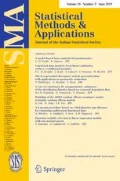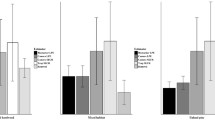Abstract
Distance sampling is extensively used for estimating animal density or abundance. Conventional methods assume that location of line or point transects is random with respect to the animal population, yet transects are often placed along linear features such as roads, rivers or shorelines that do not randomly sample the study region, resulting in biased estimates of abundance. If it is possible to collect additional data that allow an animal density gradient with respect to the transects to be modelled, we show how to extend the conventional distance sampling likelihood to give asymptotically unbiased estimates of density for the covered area. We illustrate the proposed methods using data for a kangaroo population surveyed by line transects laid along tracks, for which the true density is known from an independent source, and the density gradient with respect to the tracks is estimated from a sample of GPS collared animals. For this example, density of animals increases with distance from the tracks, so that detection probability is overestimated and density underestimated if the non-random location of transects is ignored. When we account for the density gradient, there is no evidence of bias in the abundance estimate. We end with a list of practical recommendations to investigators conducting distance sampling surveys where density gradients could be an issue.
Similar content being viewed by others
References
Borchers DL, Burnham KP (2004) General formulation for distance sampling. In: Buckland ST, Anderson DR, Burnham KP, Laake JL, Borchers DL, Thomas L (eds) Advanced distance sampling. Oxford University Press, Oxford, pp 307–392
Borchers DL, Marques TA, Gunnlaugsson T, Jupp PE (2010) Estimating distance sampling detection functions when distances are measured with errors. J Agric Biol Environ Stat 15: 346–361
Buckland ST (1992) Fitting density functions with polynomials. Appl Stat 41: 63–76
Buckland ST, Anderson DR, Burnham KP, Laake JL, Borchers DL, Thomas L (2001) Introduction to distance sampling—estimating abundance of biological populations. Oxford University Press, Oxford
Butler M, Wallace M, Ballard W, DeMaso S, Applegate R (2005) From the field: the relationship of Rio Grande wild turkey distributions to roads. Wildl Soc Bull 33(2): 745–748
Cox MJ, Borchers DL, Demer DA, Cutter GR, Brierley AS (2011) Estimating the density of antarctic krill (Euphausia superba) from multi-beam echo-sounder observations using distance sampling methods. Appl Stat 60: 301–316
del Rey EG, Rodriguez-Lorenzo JA (2011) Avian mortality due to power lines in the Canary Islands with special reference to the steppe-land birds. J Nat Hist 45: 2159–2169
Dorrough J, Yen A, Turner V, Clark SG, Crosthwaite J, Hirth JR (2004) Livestock grazing management and biodiversity conservation in Australian temperate grassy landscapes. Aust J Agric Res 55: 279–295
Erxleben D, Butler M, Ballard W, Wallace M, Peterson M, Silvy N, Kuvlesky W, Hewitt D, DeMaso S, Hardin J, Dominguez-Brazil M (2011) Wild turkey (Meleagris gallopavo) association to roads: implications for distance sampling. Eur J Wildl Res 57: 57–65
ESRI (2011) ArcGIS: Release 9.3. Redlands, California: Environmental Systems Research Institute 1999–2010
Fewster RM, Buckland ST (2004) Assessment of distance sampling estimators. In: Buckland ST, Anderson DR, Burnham KP, Laake JL, Borchers DL, Thomas L (eds) Advanced distance sampling. Oxford University Press, Oxford, pp 281–306
Fewster RM, Buckland ST, Burnham KP, Borchers DL, Jupp PE, Laake JL, Thomas L (2009) Estimating the encounter rate variance in distance sampling. Biometrics 65: 225–236
Fletcher D (2007) Pest or guest: the zoology of overabundance. Chapter Managing Eastern Grey Kangaroos Macropus giganteus in the Australian capital territory: reducing the overabundance—of opinion. Royal Zoological Society of New South Wales, Mosman, NSW, pp 117–128
Fletcher JR, Hutto LR (2006) Estimating detection probabilities of river birds using double surveys. Auk 123: 695–707
George J, Zeh J, Suydam R, Clark C (2004) Abundance and population trend (1978–2001) of western Arctic bowhead whales surveyed near Barrow. Mar Mamm Sci 20: 755–773
Giunchi D, Gaggini V, Baldaccini N (2007) Distance sampling as an effective method for monitoring feral pigeon (Columba livia f. domestica) urban populations. Urb Ecosyst 10: 397–412
Hedley SL, Buckland ST (2004) Spatial models for line transect sampling. J Agric Biol Environ Stat 9(2): 181–199
Katsanevakis S (2007) Density surface modelling with line transect sampling as a tool for abundance estimation of marine benthic species: the Pinna nobilis example in a marine lake. Mar Biol 152: 77–85
Lancia RA, Kendall WL, Pollock KH, Nichols JD (2005) Estimating the number of animals in wildlife populations. In: Techniques for wildlife investigations and management. The Wildlife Society, Bethesda, MD, pp 106–153
Marques FFC, Buckland ST (2003) Incorporating covariates into standard line transect analyses. Biometrics 59: 924–935
Marques TA, Thomas L, Fancy SG, Buckland ST (2007) Improving estimates of bird density using multiple covariate distance sampling. Auk 124: 1229–1243
Marques TA, Buckland ST, Borchers DL, Tosh D, McDonald RA (2010) Point transect sampling along linear features. Biometrics 66: 1247–1255
McShea WJ, Stewart CM, Kearns L, Bates S (2011) Road bias for deer density estimates at 2 national parks in Maryland. Wildl Soc Bull 35(3): 177–184
R Development Core Team (2012) R: a language and environment for statistical computing. R Foundation for Statistical Computing, Vienna, Austria. ISBN 3-900051-07-0
Southwell C (1989) Techniques for monitoring the abundance of kangaroo and wallaby populations. In: Grigg G, Jarman P, Hume I (eds) Kangaroos, wallabies and ratkangaroos, Surrey Beatty, Sydney, pp 659–693
Thomas L, Buckland ST, Rexstad EA, Laake JL, Strindberg S, Hedley SL, Bishop JR, Marques TA, Burnham KP (2010) Distance software: design and analysis of distance sampling surveys for estimating population size. J Appl Ecol 47: 5–14
Vargas A, Jimenez I, Palomares F, Palacios MJ (2002) Distribution, status, and conservation needs of the golden-crowned sifaka (Propithecus tattersalli). Biol Conserv 108: 325–334
Venturato E, Cavallini P, Dessa-Fulgheri F (2010) Are pheasants attracted or repelled by roads? A test of a crucial assumption for transect censuses. Eur J Wildl Res 56: 233–237
Williams BK, Nichols JD, Conroy MJ (2002) Analysis and management of animal populations. Academic Press, San Diego
Author information
Authors and Affiliations
Corresponding author
Rights and permissions
About this article
Cite this article
Marques, T.A., Buckland, S.T., Bispo, R. et al. Accounting for animal density gradients using independent information in distance sampling surveys. Stat Methods Appl 22, 67–80 (2013). https://doi.org/10.1007/s10260-012-0223-2
Accepted:
Published:
Issue Date:
DOI: https://doi.org/10.1007/s10260-012-0223-2




